Nursing Clinical Reasoning Cycle Question 2022
VerifiedAdded on 2022/09/22
|10
|2559
|22
AI Summary
Contribute Materials
Your contribution can guide someone’s learning journey. Share your
documents today.
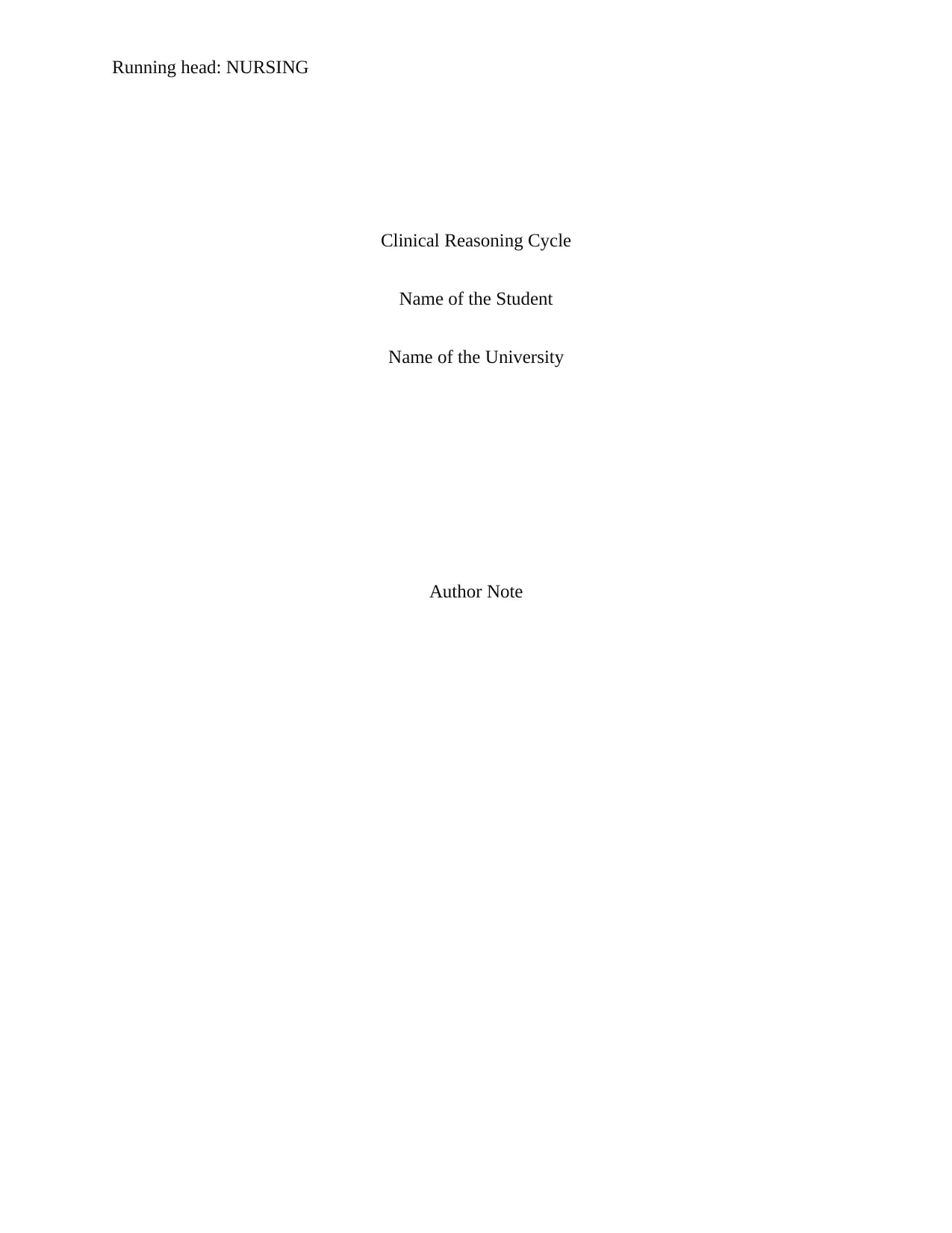
Running head: NURSING
Clinical Reasoning Cycle
Name of the Student
Name of the University
Author Note
Clinical Reasoning Cycle
Name of the Student
Name of the University
Author Note
Secure Best Marks with AI Grader
Need help grading? Try our AI Grader for instant feedback on your assignments.
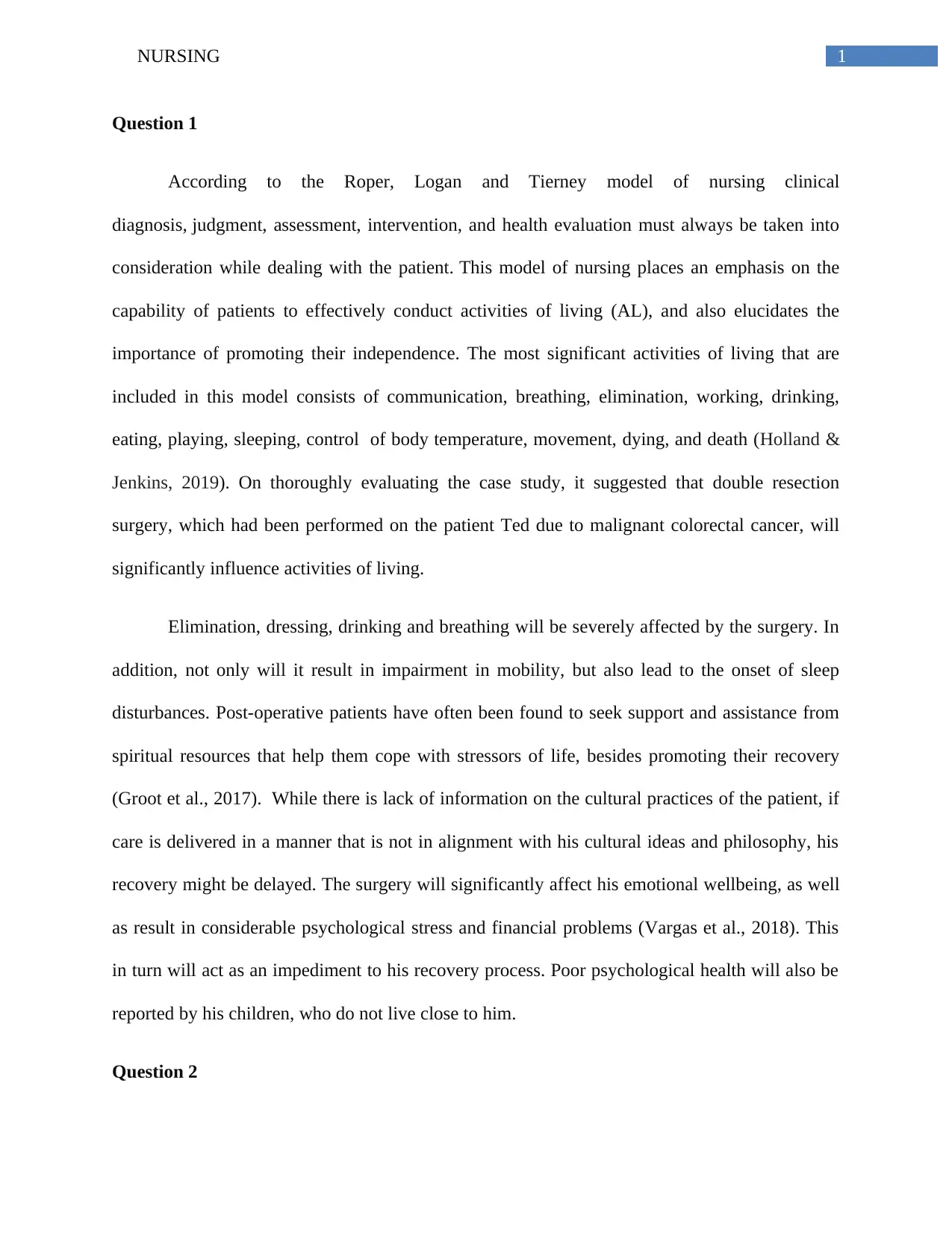
1NURSING
Question 1
According to the Roper, Logan and Tierney model of nursing clinical
diagnosis, judgment, assessment, intervention, and health evaluation must always be taken into
consideration while dealing with the patient. This model of nursing places an emphasis on the
capability of patients to effectively conduct activities of living (AL), and also elucidates the
importance of promoting their independence. The most significant activities of living that are
included in this model consists of communication, breathing, elimination, working, drinking,
eating, playing, sleeping, control of body temperature, movement, dying, and death (Holland &
Jenkins, 2019). On thoroughly evaluating the case study, it suggested that double resection
surgery, which had been performed on the patient Ted due to malignant colorectal cancer, will
significantly influence activities of living.
Elimination, dressing, drinking and breathing will be severely affected by the surgery. In
addition, not only will it result in impairment in mobility, but also lead to the onset of sleep
disturbances. Post-operative patients have often been found to seek support and assistance from
spiritual resources that help them cope with stressors of life, besides promoting their recovery
(Groot et al., 2017). While there is lack of information on the cultural practices of the patient, if
care is delivered in a manner that is not in alignment with his cultural ideas and philosophy, his
recovery might be delayed. The surgery will significantly affect his emotional wellbeing, as well
as result in considerable psychological stress and financial problems (Vargas et al., 2018). This
in turn will act as an impediment to his recovery process. Poor psychological health will also be
reported by his children, who do not live close to him.
Question 2
Question 1
According to the Roper, Logan and Tierney model of nursing clinical
diagnosis, judgment, assessment, intervention, and health evaluation must always be taken into
consideration while dealing with the patient. This model of nursing places an emphasis on the
capability of patients to effectively conduct activities of living (AL), and also elucidates the
importance of promoting their independence. The most significant activities of living that are
included in this model consists of communication, breathing, elimination, working, drinking,
eating, playing, sleeping, control of body temperature, movement, dying, and death (Holland &
Jenkins, 2019). On thoroughly evaluating the case study, it suggested that double resection
surgery, which had been performed on the patient Ted due to malignant colorectal cancer, will
significantly influence activities of living.
Elimination, dressing, drinking and breathing will be severely affected by the surgery. In
addition, not only will it result in impairment in mobility, but also lead to the onset of sleep
disturbances. Post-operative patients have often been found to seek support and assistance from
spiritual resources that help them cope with stressors of life, besides promoting their recovery
(Groot et al., 2017). While there is lack of information on the cultural practices of the patient, if
care is delivered in a manner that is not in alignment with his cultural ideas and philosophy, his
recovery might be delayed. The surgery will significantly affect his emotional wellbeing, as well
as result in considerable psychological stress and financial problems (Vargas et al., 2018). This
in turn will act as an impediment to his recovery process. Poor psychological health will also be
reported by his children, who do not live close to him.
Question 2
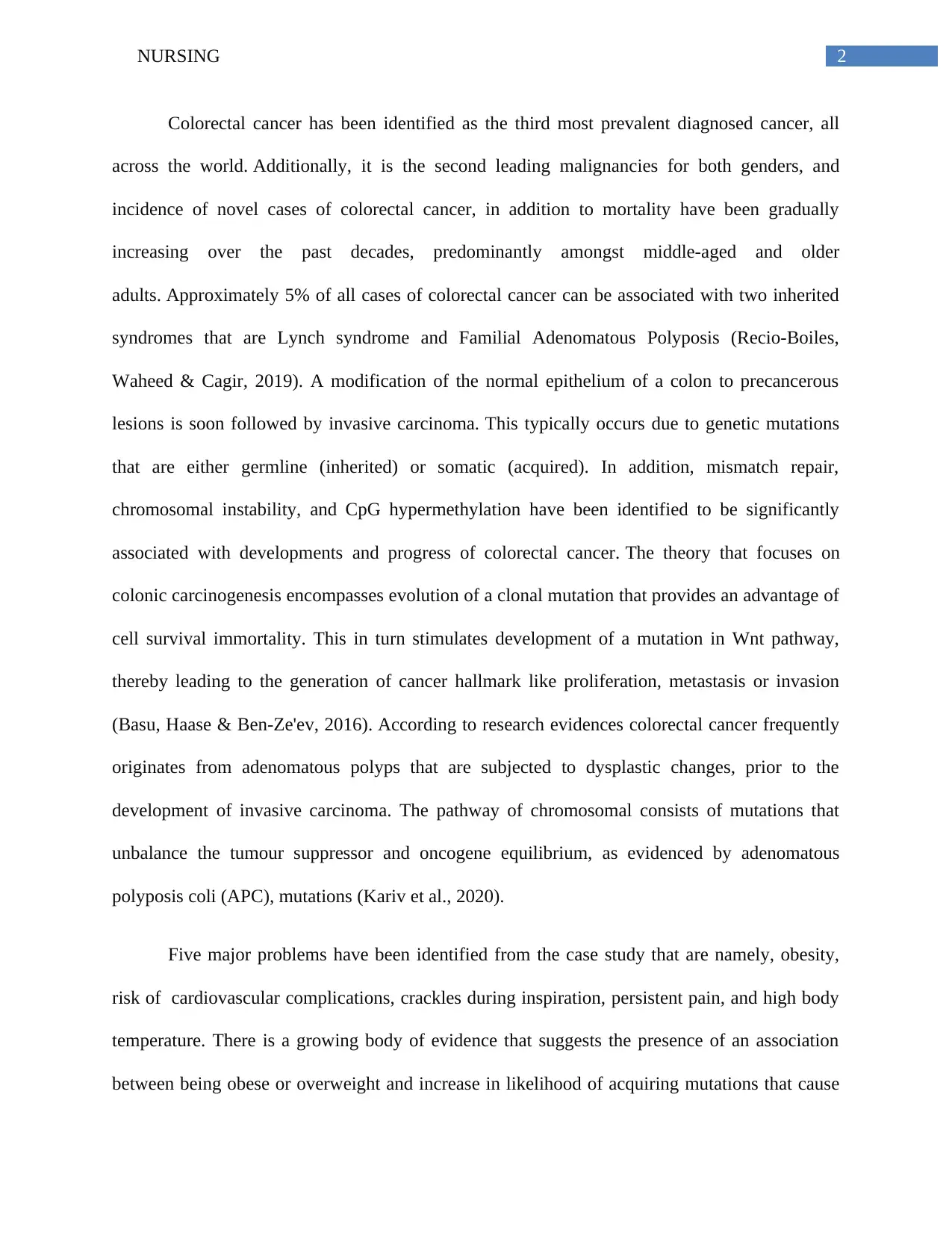
2NURSING
Colorectal cancer has been identified as the third most prevalent diagnosed cancer, all
across the world. Additionally, it is the second leading malignancies for both genders, and
incidence of novel cases of colorectal cancer, in addition to mortality have been gradually
increasing over the past decades, predominantly amongst middle-aged and older
adults. Approximately 5% of all cases of colorectal cancer can be associated with two inherited
syndromes that are Lynch syndrome and Familial Adenomatous Polyposis (Recio-Boiles,
Waheed & Cagir, 2019). A modification of the normal epithelium of a colon to precancerous
lesions is soon followed by invasive carcinoma. This typically occurs due to genetic mutations
that are either germline (inherited) or somatic (acquired). In addition, mismatch repair,
chromosomal instability, and CpG hypermethylation have been identified to be significantly
associated with developments and progress of colorectal cancer. The theory that focuses on
colonic carcinogenesis encompasses evolution of a clonal mutation that provides an advantage of
cell survival immortality. This in turn stimulates development of a mutation in Wnt pathway,
thereby leading to the generation of cancer hallmark like proliferation, metastasis or invasion
(Basu, Haase & Ben-Ze'ev, 2016). According to research evidences colorectal cancer frequently
originates from adenomatous polyps that are subjected to dysplastic changes, prior to the
development of invasive carcinoma. The pathway of chromosomal consists of mutations that
unbalance the tumour suppressor and oncogene equilibrium, as evidenced by adenomatous
polyposis coli (APC), mutations (Kariv et al., 2020).
Five major problems have been identified from the case study that are namely, obesity,
risk of cardiovascular complications, crackles during inspiration, persistent pain, and high body
temperature. There is a growing body of evidence that suggests the presence of an association
between being obese or overweight and increase in likelihood of acquiring mutations that cause
Colorectal cancer has been identified as the third most prevalent diagnosed cancer, all
across the world. Additionally, it is the second leading malignancies for both genders, and
incidence of novel cases of colorectal cancer, in addition to mortality have been gradually
increasing over the past decades, predominantly amongst middle-aged and older
adults. Approximately 5% of all cases of colorectal cancer can be associated with two inherited
syndromes that are Lynch syndrome and Familial Adenomatous Polyposis (Recio-Boiles,
Waheed & Cagir, 2019). A modification of the normal epithelium of a colon to precancerous
lesions is soon followed by invasive carcinoma. This typically occurs due to genetic mutations
that are either germline (inherited) or somatic (acquired). In addition, mismatch repair,
chromosomal instability, and CpG hypermethylation have been identified to be significantly
associated with developments and progress of colorectal cancer. The theory that focuses on
colonic carcinogenesis encompasses evolution of a clonal mutation that provides an advantage of
cell survival immortality. This in turn stimulates development of a mutation in Wnt pathway,
thereby leading to the generation of cancer hallmark like proliferation, metastasis or invasion
(Basu, Haase & Ben-Ze'ev, 2016). According to research evidences colorectal cancer frequently
originates from adenomatous polyps that are subjected to dysplastic changes, prior to the
development of invasive carcinoma. The pathway of chromosomal consists of mutations that
unbalance the tumour suppressor and oncogene equilibrium, as evidenced by adenomatous
polyposis coli (APC), mutations (Kariv et al., 2020).
Five major problems have been identified from the case study that are namely, obesity,
risk of cardiovascular complications, crackles during inspiration, persistent pain, and high body
temperature. There is a growing body of evidence that suggests the presence of an association
between being obese or overweight and increase in likelihood of acquiring mutations that cause
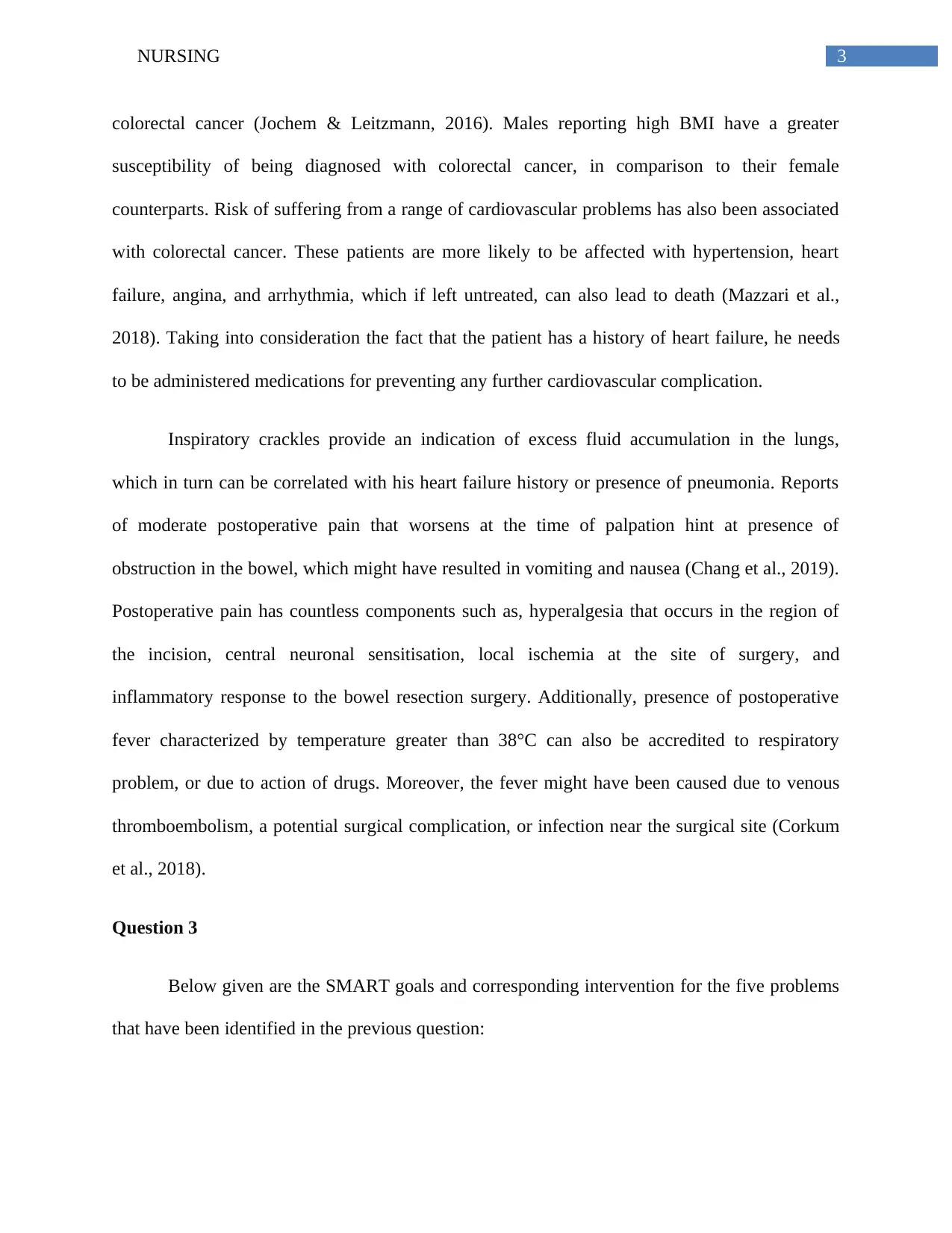
3NURSING
colorectal cancer (Jochem & Leitzmann, 2016). Males reporting high BMI have a greater
susceptibility of being diagnosed with colorectal cancer, in comparison to their female
counterparts. Risk of suffering from a range of cardiovascular problems has also been associated
with colorectal cancer. These patients are more likely to be affected with hypertension, heart
failure, angina, and arrhythmia, which if left untreated, can also lead to death (Mazzari et al.,
2018). Taking into consideration the fact that the patient has a history of heart failure, he needs
to be administered medications for preventing any further cardiovascular complication.
Inspiratory crackles provide an indication of excess fluid accumulation in the lungs,
which in turn can be correlated with his heart failure history or presence of pneumonia. Reports
of moderate postoperative pain that worsens at the time of palpation hint at presence of
obstruction in the bowel, which might have resulted in vomiting and nausea (Chang et al., 2019).
Postoperative pain has countless components such as, hyperalgesia that occurs in the region of
the incision, central neuronal sensitisation, local ischemia at the site of surgery, and
inflammatory response to the bowel resection surgery. Additionally, presence of postoperative
fever characterized by temperature greater than 38°C can also be accredited to respiratory
problem, or due to action of drugs. Moreover, the fever might have been caused due to venous
thromboembolism, a potential surgical complication, or infection near the surgical site (Corkum
et al., 2018).
Question 3
Below given are the SMART goals and corresponding intervention for the five problems
that have been identified in the previous question:
colorectal cancer (Jochem & Leitzmann, 2016). Males reporting high BMI have a greater
susceptibility of being diagnosed with colorectal cancer, in comparison to their female
counterparts. Risk of suffering from a range of cardiovascular problems has also been associated
with colorectal cancer. These patients are more likely to be affected with hypertension, heart
failure, angina, and arrhythmia, which if left untreated, can also lead to death (Mazzari et al.,
2018). Taking into consideration the fact that the patient has a history of heart failure, he needs
to be administered medications for preventing any further cardiovascular complication.
Inspiratory crackles provide an indication of excess fluid accumulation in the lungs,
which in turn can be correlated with his heart failure history or presence of pneumonia. Reports
of moderate postoperative pain that worsens at the time of palpation hint at presence of
obstruction in the bowel, which might have resulted in vomiting and nausea (Chang et al., 2019).
Postoperative pain has countless components such as, hyperalgesia that occurs in the region of
the incision, central neuronal sensitisation, local ischemia at the site of surgery, and
inflammatory response to the bowel resection surgery. Additionally, presence of postoperative
fever characterized by temperature greater than 38°C can also be accredited to respiratory
problem, or due to action of drugs. Moreover, the fever might have been caused due to venous
thromboembolism, a potential surgical complication, or infection near the surgical site (Corkum
et al., 2018).
Question 3
Below given are the SMART goals and corresponding intervention for the five problems
that have been identified in the previous question:
Secure Best Marks with AI Grader
Need help grading? Try our AI Grader for instant feedback on your assignments.
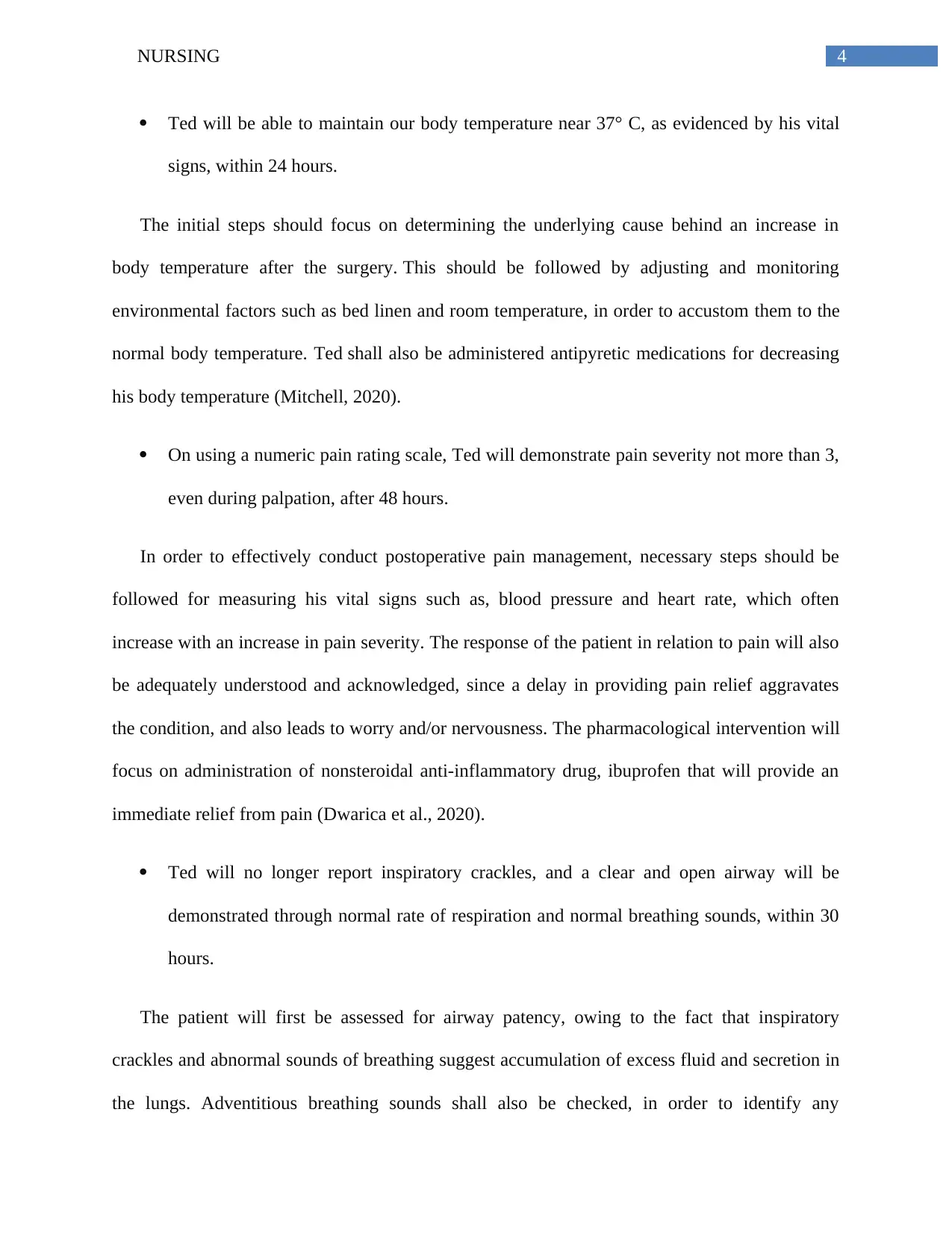
4NURSING
Ted will be able to maintain our body temperature near 37° C, as evidenced by his vital
signs, within 24 hours.
The initial steps should focus on determining the underlying cause behind an increase in
body temperature after the surgery. This should be followed by adjusting and monitoring
environmental factors such as bed linen and room temperature, in order to accustom them to the
normal body temperature. Ted shall also be administered antipyretic medications for decreasing
his body temperature (Mitchell, 2020).
On using a numeric pain rating scale, Ted will demonstrate pain severity not more than 3,
even during palpation, after 48 hours.
In order to effectively conduct postoperative pain management, necessary steps should be
followed for measuring his vital signs such as, blood pressure and heart rate, which often
increase with an increase in pain severity. The response of the patient in relation to pain will also
be adequately understood and acknowledged, since a delay in providing pain relief aggravates
the condition, and also leads to worry and/or nervousness. The pharmacological intervention will
focus on administration of nonsteroidal anti-inflammatory drug, ibuprofen that will provide an
immediate relief from pain (Dwarica et al., 2020).
Ted will no longer report inspiratory crackles, and a clear and open airway will be
demonstrated through normal rate of respiration and normal breathing sounds, within 30
hours.
The patient will first be assessed for airway patency, owing to the fact that inspiratory
crackles and abnormal sounds of breathing suggest accumulation of excess fluid and secretion in
the lungs. Adventitious breathing sounds shall also be checked, in order to identify any
Ted will be able to maintain our body temperature near 37° C, as evidenced by his vital
signs, within 24 hours.
The initial steps should focus on determining the underlying cause behind an increase in
body temperature after the surgery. This should be followed by adjusting and monitoring
environmental factors such as bed linen and room temperature, in order to accustom them to the
normal body temperature. Ted shall also be administered antipyretic medications for decreasing
his body temperature (Mitchell, 2020).
On using a numeric pain rating scale, Ted will demonstrate pain severity not more than 3,
even during palpation, after 48 hours.
In order to effectively conduct postoperative pain management, necessary steps should be
followed for measuring his vital signs such as, blood pressure and heart rate, which often
increase with an increase in pain severity. The response of the patient in relation to pain will also
be adequately understood and acknowledged, since a delay in providing pain relief aggravates
the condition, and also leads to worry and/or nervousness. The pharmacological intervention will
focus on administration of nonsteroidal anti-inflammatory drug, ibuprofen that will provide an
immediate relief from pain (Dwarica et al., 2020).
Ted will no longer report inspiratory crackles, and a clear and open airway will be
demonstrated through normal rate of respiration and normal breathing sounds, within 30
hours.
The patient will first be assessed for airway patency, owing to the fact that inspiratory
crackles and abnormal sounds of breathing suggest accumulation of excess fluid and secretion in
the lungs. Adventitious breathing sounds shall also be checked, in order to identify any
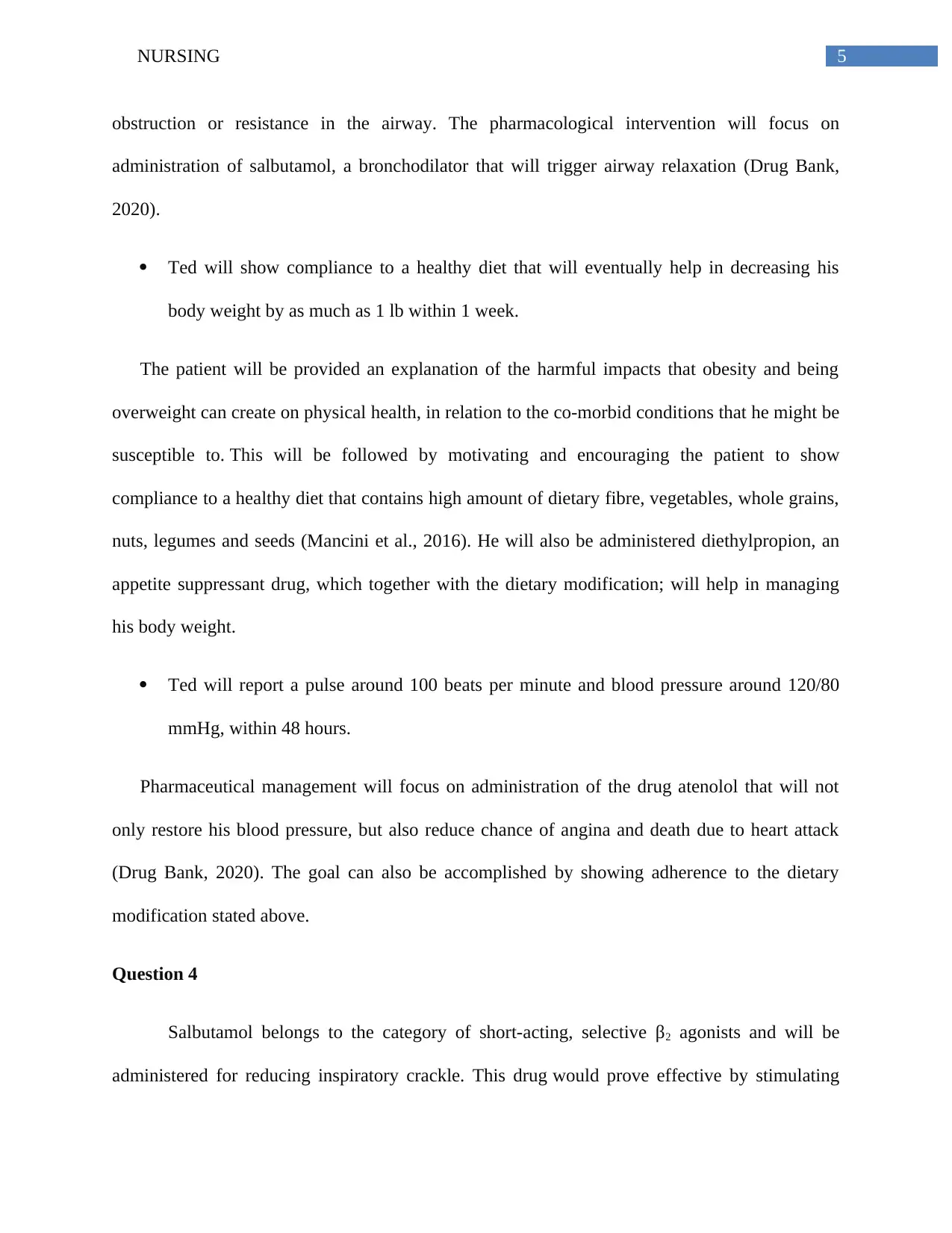
5NURSING
obstruction or resistance in the airway. The pharmacological intervention will focus on
administration of salbutamol, a bronchodilator that will trigger airway relaxation (Drug Bank,
2020).
Ted will show compliance to a healthy diet that will eventually help in decreasing his
body weight by as much as 1 lb within 1 week.
The patient will be provided an explanation of the harmful impacts that obesity and being
overweight can create on physical health, in relation to the co-morbid conditions that he might be
susceptible to. This will be followed by motivating and encouraging the patient to show
compliance to a healthy diet that contains high amount of dietary fibre, vegetables, whole grains,
nuts, legumes and seeds (Mancini et al., 2016). He will also be administered diethylpropion, an
appetite suppressant drug, which together with the dietary modification; will help in managing
his body weight.
Ted will report a pulse around 100 beats per minute and blood pressure around 120/80
mmHg, within 48 hours.
Pharmaceutical management will focus on administration of the drug atenolol that will not
only restore his blood pressure, but also reduce chance of angina and death due to heart attack
(Drug Bank, 2020). The goal can also be accomplished by showing adherence to the dietary
modification stated above.
Question 4
Salbutamol belongs to the category of short-acting, selective β2 agonists and will be
administered for reducing inspiratory crackle. This drug would prove effective by stimulating
obstruction or resistance in the airway. The pharmacological intervention will focus on
administration of salbutamol, a bronchodilator that will trigger airway relaxation (Drug Bank,
2020).
Ted will show compliance to a healthy diet that will eventually help in decreasing his
body weight by as much as 1 lb within 1 week.
The patient will be provided an explanation of the harmful impacts that obesity and being
overweight can create on physical health, in relation to the co-morbid conditions that he might be
susceptible to. This will be followed by motivating and encouraging the patient to show
compliance to a healthy diet that contains high amount of dietary fibre, vegetables, whole grains,
nuts, legumes and seeds (Mancini et al., 2016). He will also be administered diethylpropion, an
appetite suppressant drug, which together with the dietary modification; will help in managing
his body weight.
Ted will report a pulse around 100 beats per minute and blood pressure around 120/80
mmHg, within 48 hours.
Pharmaceutical management will focus on administration of the drug atenolol that will not
only restore his blood pressure, but also reduce chance of angina and death due to heart attack
(Drug Bank, 2020). The goal can also be accomplished by showing adherence to the dietary
modification stated above.
Question 4
Salbutamol belongs to the category of short-acting, selective β2 agonists and will be
administered for reducing inspiratory crackle. This drug would prove effective by stimulating
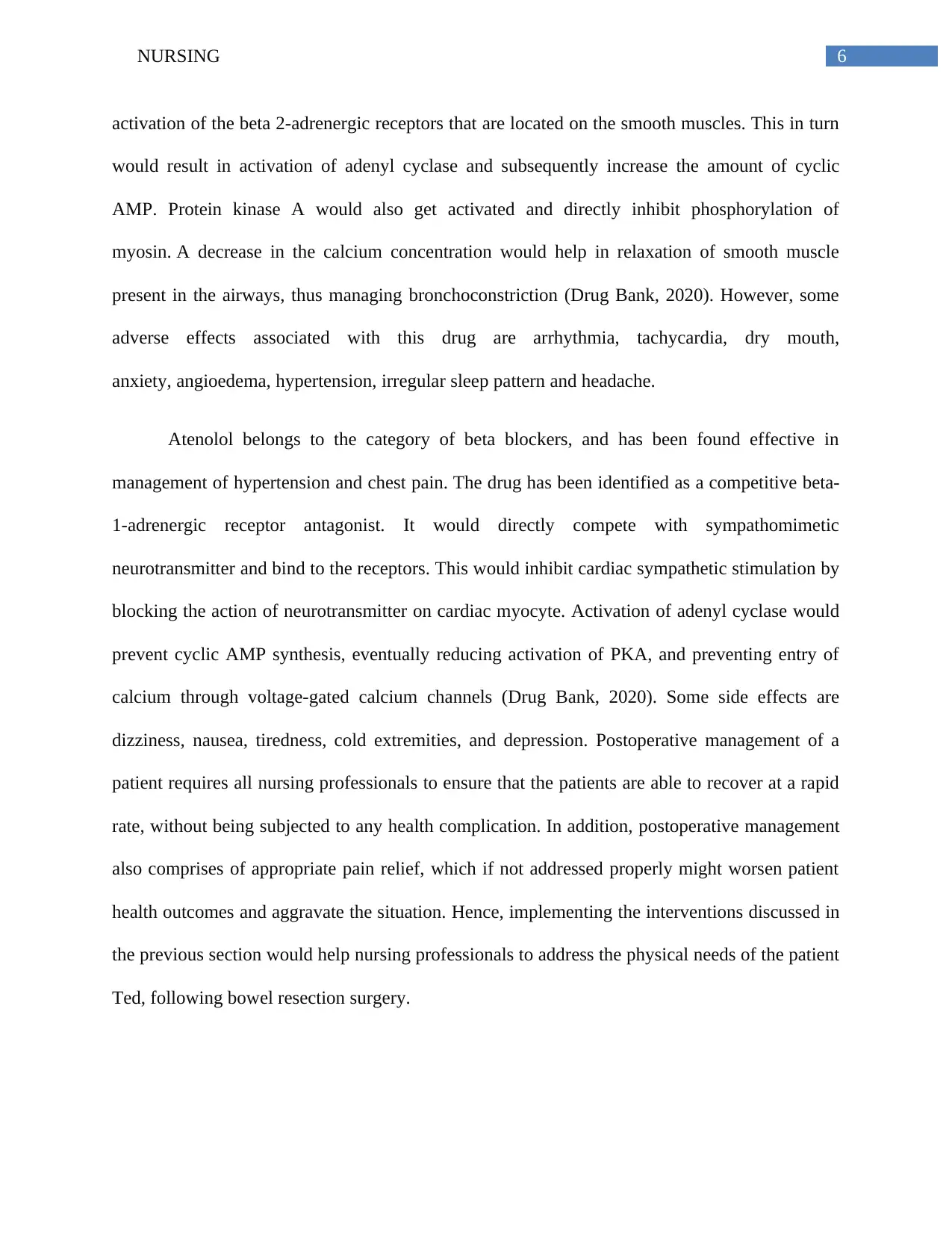
6NURSING
activation of the beta 2-adrenergic receptors that are located on the smooth muscles. This in turn
would result in activation of adenyl cyclase and subsequently increase the amount of cyclic
AMP. Protein kinase A would also get activated and directly inhibit phosphorylation of
myosin. A decrease in the calcium concentration would help in relaxation of smooth muscle
present in the airways, thus managing bronchoconstriction (Drug Bank, 2020). However, some
adverse effects associated with this drug are arrhythmia, tachycardia, dry mouth,
anxiety, angioedema, hypertension, irregular sleep pattern and headache.
Atenolol belongs to the category of beta blockers, and has been found effective in
management of hypertension and chest pain. The drug has been identified as a competitive beta-
1-adrenergic receptor antagonist. It would directly compete with sympathomimetic
neurotransmitter and bind to the receptors. This would inhibit cardiac sympathetic stimulation by
blocking the action of neurotransmitter on cardiac myocyte. Activation of adenyl cyclase would
prevent cyclic AMP synthesis, eventually reducing activation of PKA, and preventing entry of
calcium through voltage-gated calcium channels (Drug Bank, 2020). Some side effects are
dizziness, nausea, tiredness, cold extremities, and depression. Postoperative management of a
patient requires all nursing professionals to ensure that the patients are able to recover at a rapid
rate, without being subjected to any health complication. In addition, postoperative management
also comprises of appropriate pain relief, which if not addressed properly might worsen patient
health outcomes and aggravate the situation. Hence, implementing the interventions discussed in
the previous section would help nursing professionals to address the physical needs of the patient
Ted, following bowel resection surgery.
activation of the beta 2-adrenergic receptors that are located on the smooth muscles. This in turn
would result in activation of adenyl cyclase and subsequently increase the amount of cyclic
AMP. Protein kinase A would also get activated and directly inhibit phosphorylation of
myosin. A decrease in the calcium concentration would help in relaxation of smooth muscle
present in the airways, thus managing bronchoconstriction (Drug Bank, 2020). However, some
adverse effects associated with this drug are arrhythmia, tachycardia, dry mouth,
anxiety, angioedema, hypertension, irregular sleep pattern and headache.
Atenolol belongs to the category of beta blockers, and has been found effective in
management of hypertension and chest pain. The drug has been identified as a competitive beta-
1-adrenergic receptor antagonist. It would directly compete with sympathomimetic
neurotransmitter and bind to the receptors. This would inhibit cardiac sympathetic stimulation by
blocking the action of neurotransmitter on cardiac myocyte. Activation of adenyl cyclase would
prevent cyclic AMP synthesis, eventually reducing activation of PKA, and preventing entry of
calcium through voltage-gated calcium channels (Drug Bank, 2020). Some side effects are
dizziness, nausea, tiredness, cold extremities, and depression. Postoperative management of a
patient requires all nursing professionals to ensure that the patients are able to recover at a rapid
rate, without being subjected to any health complication. In addition, postoperative management
also comprises of appropriate pain relief, which if not addressed properly might worsen patient
health outcomes and aggravate the situation. Hence, implementing the interventions discussed in
the previous section would help nursing professionals to address the physical needs of the patient
Ted, following bowel resection surgery.
Paraphrase This Document
Need a fresh take? Get an instant paraphrase of this document with our AI Paraphraser
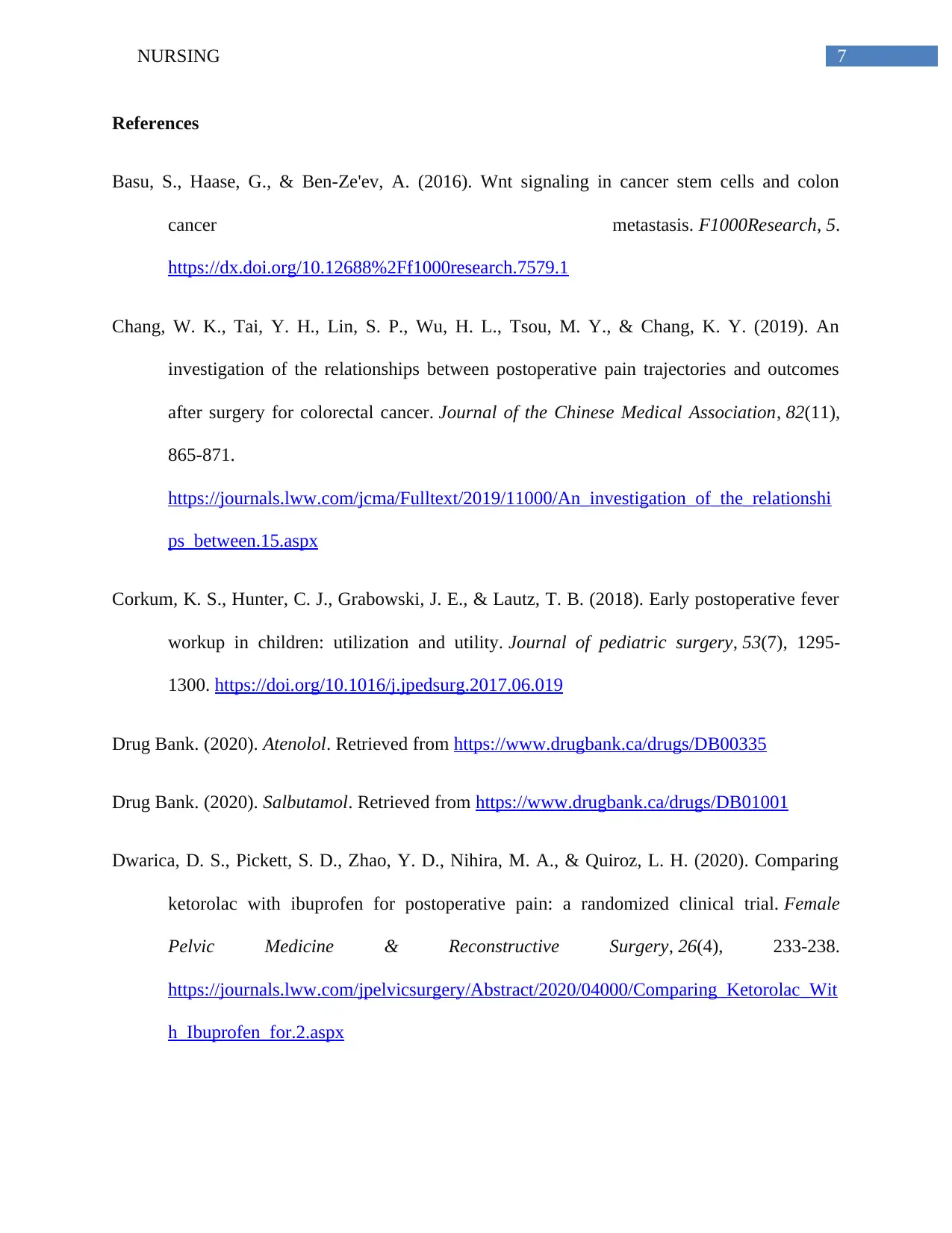
7NURSING
References
Basu, S., Haase, G., & Ben-Ze'ev, A. (2016). Wnt signaling in cancer stem cells and colon
cancer metastasis. F1000Research, 5.
https://dx.doi.org/10.12688%2Ff1000research.7579.1
Chang, W. K., Tai, Y. H., Lin, S. P., Wu, H. L., Tsou, M. Y., & Chang, K. Y. (2019). An
investigation of the relationships between postoperative pain trajectories and outcomes
after surgery for colorectal cancer. Journal of the Chinese Medical Association, 82(11),
865-871.
https://journals.lww.com/jcma/Fulltext/2019/11000/An_investigation_of_the_relationshi
ps_between.15.aspx
Corkum, K. S., Hunter, C. J., Grabowski, J. E., & Lautz, T. B. (2018). Early postoperative fever
workup in children: utilization and utility. Journal of pediatric surgery, 53(7), 1295-
1300. https://doi.org/10.1016/j.jpedsurg.2017.06.019
Drug Bank. (2020). Atenolol. Retrieved from https://www.drugbank.ca/drugs/DB00335
Drug Bank. (2020). Salbutamol. Retrieved from https://www.drugbank.ca/drugs/DB01001
Dwarica, D. S., Pickett, S. D., Zhao, Y. D., Nihira, M. A., & Quiroz, L. H. (2020). Comparing
ketorolac with ibuprofen for postoperative pain: a randomized clinical trial. Female
Pelvic Medicine & Reconstructive Surgery, 26(4), 233-238.
https://journals.lww.com/jpelvicsurgery/Abstract/2020/04000/Comparing_Ketorolac_Wit
h_Ibuprofen_for.2.aspx
References
Basu, S., Haase, G., & Ben-Ze'ev, A. (2016). Wnt signaling in cancer stem cells and colon
cancer metastasis. F1000Research, 5.
https://dx.doi.org/10.12688%2Ff1000research.7579.1
Chang, W. K., Tai, Y. H., Lin, S. P., Wu, H. L., Tsou, M. Y., & Chang, K. Y. (2019). An
investigation of the relationships between postoperative pain trajectories and outcomes
after surgery for colorectal cancer. Journal of the Chinese Medical Association, 82(11),
865-871.
https://journals.lww.com/jcma/Fulltext/2019/11000/An_investigation_of_the_relationshi
ps_between.15.aspx
Corkum, K. S., Hunter, C. J., Grabowski, J. E., & Lautz, T. B. (2018). Early postoperative fever
workup in children: utilization and utility. Journal of pediatric surgery, 53(7), 1295-
1300. https://doi.org/10.1016/j.jpedsurg.2017.06.019
Drug Bank. (2020). Atenolol. Retrieved from https://www.drugbank.ca/drugs/DB00335
Drug Bank. (2020). Salbutamol. Retrieved from https://www.drugbank.ca/drugs/DB01001
Dwarica, D. S., Pickett, S. D., Zhao, Y. D., Nihira, M. A., & Quiroz, L. H. (2020). Comparing
ketorolac with ibuprofen for postoperative pain: a randomized clinical trial. Female
Pelvic Medicine & Reconstructive Surgery, 26(4), 233-238.
https://journals.lww.com/jpelvicsurgery/Abstract/2020/04000/Comparing_Ketorolac_Wit
h_Ibuprofen_for.2.aspx
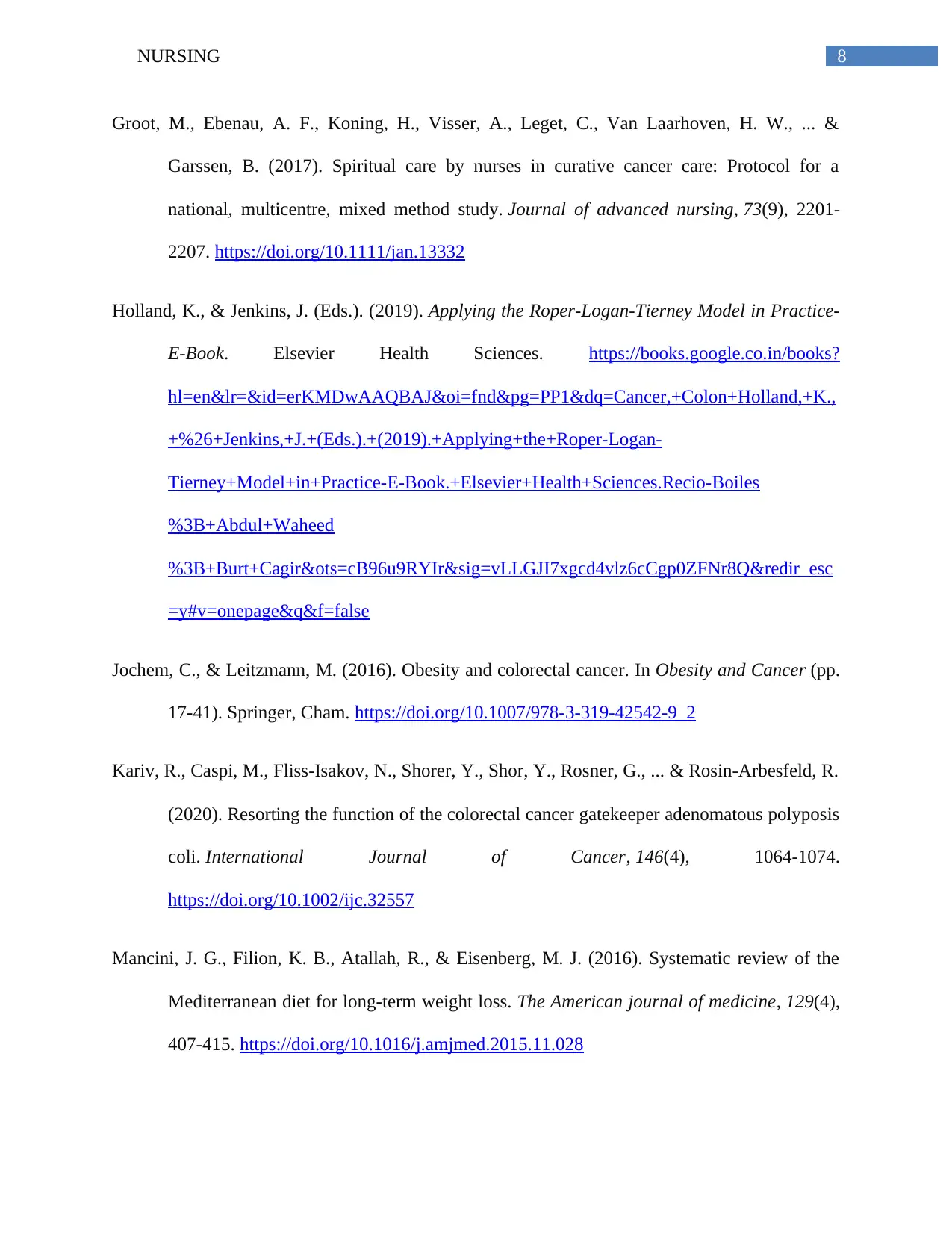
8NURSING
Groot, M., Ebenau, A. F., Koning, H., Visser, A., Leget, C., Van Laarhoven, H. W., ... &
Garssen, B. (2017). Spiritual care by nurses in curative cancer care: Protocol for a
national, multicentre, mixed method study. Journal of advanced nursing, 73(9), 2201-
2207. https://doi.org/10.1111/jan.13332
Holland, K., & Jenkins, J. (Eds.). (2019). Applying the Roper-Logan-Tierney Model in Practice-
E-Book. Elsevier Health Sciences. https://books.google.co.in/books?
hl=en&lr=&id=erKMDwAAQBAJ&oi=fnd&pg=PP1&dq=Cancer,+Colon+Holland,+K.,
+%26+Jenkins,+J.+(Eds.).+(2019).+Applying+the+Roper-Logan-
Tierney+Model+in+Practice-E-Book.+Elsevier+Health+Sciences.Recio-Boiles
%3B+Abdul+Waheed
%3B+Burt+Cagir&ots=cB96u9RYIr&sig=vLLGJI7xgcd4vlz6cCgp0ZFNr8Q&redir_esc
=y#v=onepage&q&f=false
Jochem, C., & Leitzmann, M. (2016). Obesity and colorectal cancer. In Obesity and Cancer (pp.
17-41). Springer, Cham. https://doi.org/10.1007/978-3-319-42542-9_2
Kariv, R., Caspi, M., Fliss‐Isakov, N., Shorer, Y., Shor, Y., Rosner, G., ... & Rosin‐Arbesfeld, R.
(2020). Resorting the function of the colorectal cancer gatekeeper adenomatous polyposis
coli. International Journal of Cancer, 146(4), 1064-1074.
https://doi.org/10.1002/ijc.32557
Mancini, J. G., Filion, K. B., Atallah, R., & Eisenberg, M. J. (2016). Systematic review of the
Mediterranean diet for long-term weight loss. The American journal of medicine, 129(4),
407-415. https://doi.org/10.1016/j.amjmed.2015.11.028
Groot, M., Ebenau, A. F., Koning, H., Visser, A., Leget, C., Van Laarhoven, H. W., ... &
Garssen, B. (2017). Spiritual care by nurses in curative cancer care: Protocol for a
national, multicentre, mixed method study. Journal of advanced nursing, 73(9), 2201-
2207. https://doi.org/10.1111/jan.13332
Holland, K., & Jenkins, J. (Eds.). (2019). Applying the Roper-Logan-Tierney Model in Practice-
E-Book. Elsevier Health Sciences. https://books.google.co.in/books?
hl=en&lr=&id=erKMDwAAQBAJ&oi=fnd&pg=PP1&dq=Cancer,+Colon+Holland,+K.,
+%26+Jenkins,+J.+(Eds.).+(2019).+Applying+the+Roper-Logan-
Tierney+Model+in+Practice-E-Book.+Elsevier+Health+Sciences.Recio-Boiles
%3B+Abdul+Waheed
%3B+Burt+Cagir&ots=cB96u9RYIr&sig=vLLGJI7xgcd4vlz6cCgp0ZFNr8Q&redir_esc
=y#v=onepage&q&f=false
Jochem, C., & Leitzmann, M. (2016). Obesity and colorectal cancer. In Obesity and Cancer (pp.
17-41). Springer, Cham. https://doi.org/10.1007/978-3-319-42542-9_2
Kariv, R., Caspi, M., Fliss‐Isakov, N., Shorer, Y., Shor, Y., Rosner, G., ... & Rosin‐Arbesfeld, R.
(2020). Resorting the function of the colorectal cancer gatekeeper adenomatous polyposis
coli. International Journal of Cancer, 146(4), 1064-1074.
https://doi.org/10.1002/ijc.32557
Mancini, J. G., Filion, K. B., Atallah, R., & Eisenberg, M. J. (2016). Systematic review of the
Mediterranean diet for long-term weight loss. The American journal of medicine, 129(4),
407-415. https://doi.org/10.1016/j.amjmed.2015.11.028
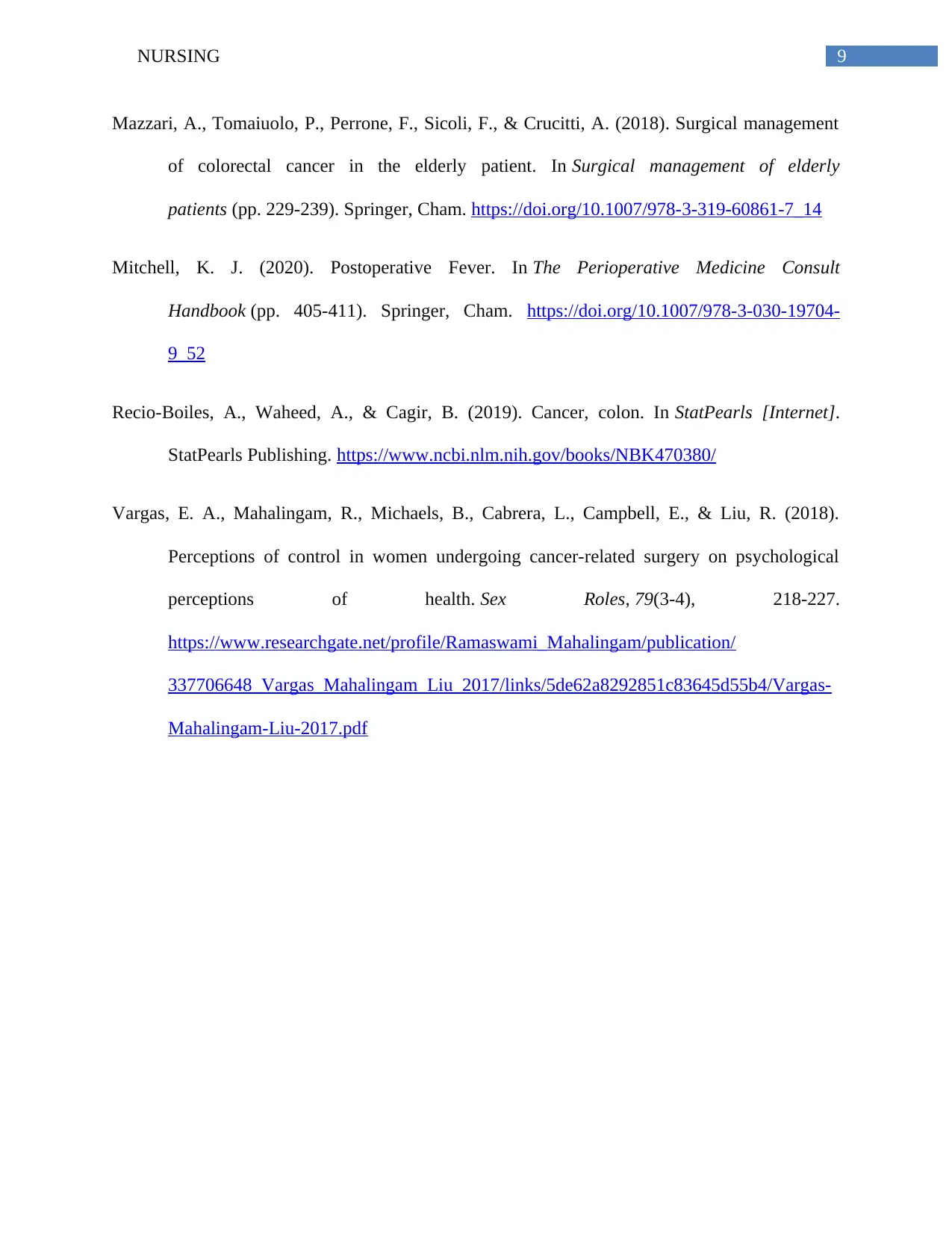
9NURSING
Mazzari, A., Tomaiuolo, P., Perrone, F., Sicoli, F., & Crucitti, A. (2018). Surgical management
of colorectal cancer in the elderly patient. In Surgical management of elderly
patients (pp. 229-239). Springer, Cham. https://doi.org/10.1007/978-3-319-60861-7_14
Mitchell, K. J. (2020). Postoperative Fever. In The Perioperative Medicine Consult
Handbook (pp. 405-411). Springer, Cham. https://doi.org/10.1007/978-3-030-19704-
9_52
Recio-Boiles, A., Waheed, A., & Cagir, B. (2019). Cancer, colon. In StatPearls [Internet].
StatPearls Publishing. https://www.ncbi.nlm.nih.gov/books/NBK470380/
Vargas, E. A., Mahalingam, R., Michaels, B., Cabrera, L., Campbell, E., & Liu, R. (2018).
Perceptions of control in women undergoing cancer-related surgery on psychological
perceptions of health. Sex Roles, 79(3-4), 218-227.
https://www.researchgate.net/profile/Ramaswami_Mahalingam/publication/
337706648_Vargas_Mahalingam_Liu_2017/links/5de62a8292851c83645d55b4/Vargas-
Mahalingam-Liu-2017.pdf
Mazzari, A., Tomaiuolo, P., Perrone, F., Sicoli, F., & Crucitti, A. (2018). Surgical management
of colorectal cancer in the elderly patient. In Surgical management of elderly
patients (pp. 229-239). Springer, Cham. https://doi.org/10.1007/978-3-319-60861-7_14
Mitchell, K. J. (2020). Postoperative Fever. In The Perioperative Medicine Consult
Handbook (pp. 405-411). Springer, Cham. https://doi.org/10.1007/978-3-030-19704-
9_52
Recio-Boiles, A., Waheed, A., & Cagir, B. (2019). Cancer, colon. In StatPearls [Internet].
StatPearls Publishing. https://www.ncbi.nlm.nih.gov/books/NBK470380/
Vargas, E. A., Mahalingam, R., Michaels, B., Cabrera, L., Campbell, E., & Liu, R. (2018).
Perceptions of control in women undergoing cancer-related surgery on psychological
perceptions of health. Sex Roles, 79(3-4), 218-227.
https://www.researchgate.net/profile/Ramaswami_Mahalingam/publication/
337706648_Vargas_Mahalingam_Liu_2017/links/5de62a8292851c83645d55b4/Vargas-
Mahalingam-Liu-2017.pdf
1 out of 10
Related Documents
Your All-in-One AI-Powered Toolkit for Academic Success.
+13062052269
info@desklib.com
Available 24*7 on WhatsApp / Email
![[object Object]](/_next/static/media/star-bottom.7253800d.svg)
Unlock your academic potential
© 2024 | Zucol Services PVT LTD | All rights reserved.





